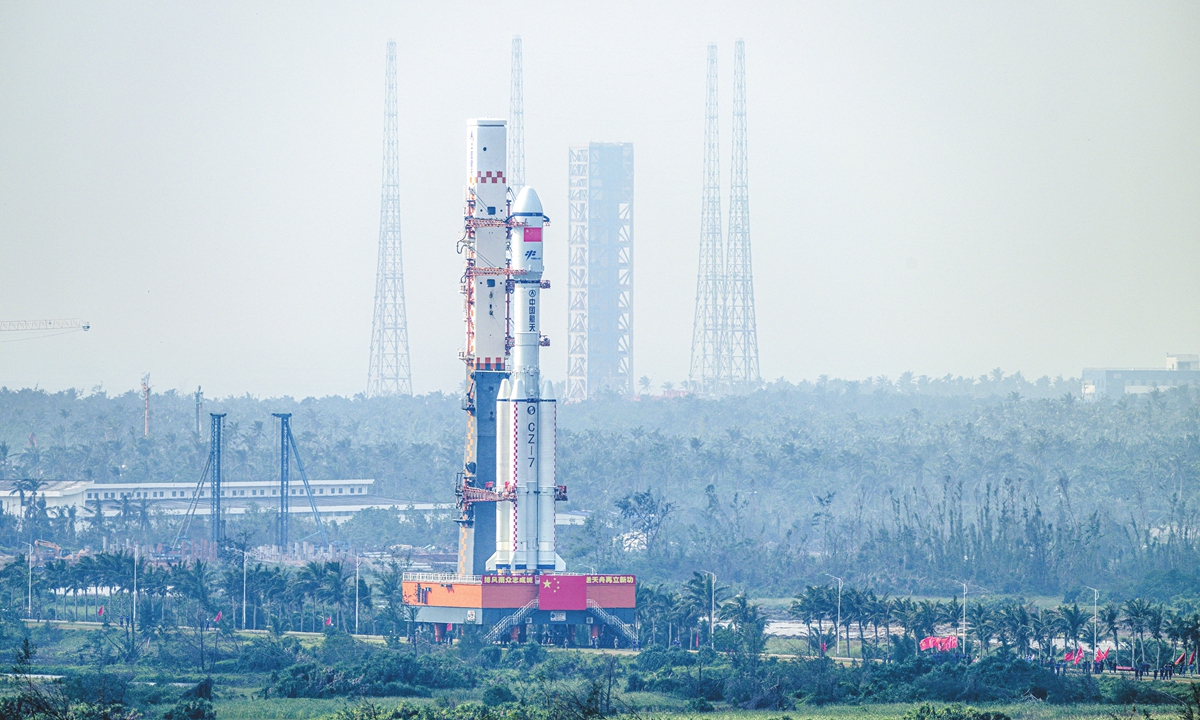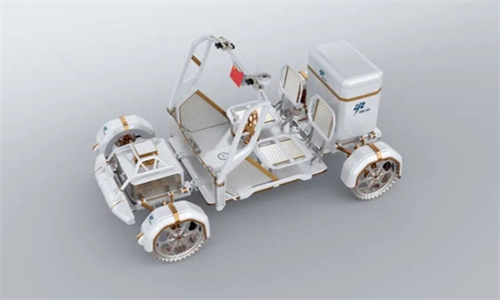
This photo taken on November 13, 2024 shows the combination of the Tianzhou-8 cargo spacecraft and a Long March-7 Y9 carrier rocket after being vertically transferred to the launch site in Wenchang, South China's Hainan Province. Photo: VCG
China's Tianzhou-8 cargo spacecraft is set to launch in the coming days, after it was vertically transported to Wenchang Space Launch Site in South China's Hainan Province together with its launch vehicle, a Long March-7 Y9 rocket, on Wednesday, the China Manned Space Agency (CMSA) announced. All systems are now set and ready for the launch, it said.
As the cargo spacecraft with the highest payload capacity in the world, Tianzhou-8 will deliver supplies to China's Tiangong space station for the crew of Shenzhou-19 which is currently in orbit, and the next Shenzhou-20 crew, as well as special birthday gifts for them. But the one item of cargo that has captured the most attention is the "lunar soil bricks," which will mark the first intersection of China's manned lunar landing and manned space station projects, experts said.
An all-system rehearsal was conducted at the Wenchang launch site on Wednesday morning, reported China Central Television (CCTV). All systems involved in the launch mission have completed functional checks and are fully prepared for launch, the report said, adding that this rehearsal is the most extensive simulation exercise for the Tianzhou-8 mission, involving the maximum number of participating systems aside from the actual ignition and launch.
Currently, the flight control team is closely monitoring the attitude and orbital parameters of the Chinese space station, which is in good condition and well prepared to welcome the Tianzhou-8 for its backward docking, CCTV reported.
The Shenzhou-19 crew onboard the Tiangong is also conducting manual remote operation training to prepare for the arrival of Tianzhou-8.
The Tianzhou-8 mission is taking place nearly 10 months after the launch of Tianzhou-7, setting a new record for the longest interval between China's cargo resupply to the space station.
China's cargo ships incorporate technical improvements with each mission. For instance, the original schedule of two missions a year has now been adjusted to three missions every two years, averaging one mission every eight months, with task frequency expected to be further reduced.
It highlights the significant advancements in Tianzhou's payload capacity, Kang Guohua, a senior member of the Chinese Society of Astronautics and a professor of Aerospace Engineering at Nanjing University of Aeronautics and Astronautics, told the Global Times on Wednesday.
This rapid development positions the Tianzhou series as a global leader in space cargo delivery. "It is not just reflected in cutting-edge technology, but in comprehensive capabilities," said Wang Yanan, chief editor of the Beijing-based Aerospace Knowledge magazine. "Our design prioritizes the efficient use of space and maximizing cargo volume to support long-duration stays in space. Combined with the strong payload capacity of China's carrier rockets, the Tianzhou cargo ships can now meet space station supply needs for up to 10 months, which is truly remarkable," Wang told the Global Times.
Compared to the US Dragon cargo spacecraft, China's Tianzhou series boasts outstanding load capacity. The Dragon has a maximum payload capacity of 6 tons, while the Tianzhou series can accommodate 7.4 tons, according to open data.
Preparing for moon stay
Currently, the Tianzhou-8 cargo spacecraft is sitting steadily within the fairing at the top of the rocket. Most of the cargo is loaded, which is primarily intended to support the Shenzhou-19 and Shenzhou-20 crews, CCTV reported.
In addition to essential supplies, there are gift packages for various festivals such as the Spring Festival, Mid-Autumn Festival and Dragon Boat Festival. Personalized birthday gifts have been prepared for each taikonaut who will celebrate a birthday in space.
Furthermore, equipment and materials needed for conducting space science experiments and tests are loaded. Notably, this mission will carry "lunar soil bricks" for the first time, which are made from special materials that simulate lunar soil.
These bricks will undergo space exposure experiments at the space station to verify whether they can be used for building structures on the moon. After completing the experiments, the first brick is expected to return to Earth by the end of next year, CCTV reported.
The bricks have a density comparable to that of ordinary bricks, but their compressive strength exceeds that of standard red bricks and concrete bricks by more than three times, with one square centimeter able to support over 10 tons of weight, said Zhou Cheng, a professor from National Center of Technology Innovation for Digital Construction, told CCTV in a previous interview.
The bricks are composed of five different components that resemble those on the moon, including a simulated lunar mare - where the Chang'e-5 mission landed. They consist mainly of basalt-based simulated lunar soil. There are also components representing the lunar soil that will be used for future missions, including Chang'e-7 and -8, which will land in the lunar highlands, primarily composed of plagioclase (a type of feldspar), Zhou said.
The "lunar soil bricks" have already attracted significant attention, as it marks the first intersection of China's manned lunar landing and manned space station projects, Kang told the Global Times.
"To achieve a long-term human presence on the moon in the future, it is essential to be able to build structures. However, as transporting materials from the Earth is impractical, people will need to utilize local resources such as lunar soil, solar energy and minerals, to create the bricks," Kang said, adding that "before getting there, scientists will need to verify a number of designs so that's why we have simulated ones."
After the bricks arrive at the space station, the crew will test their ability to withstand harsh conditions, including extreme temperature fluctuations, lack of atmospheric protection and strong cosmic radiation. This will provide important support for the construction of future lunar research stations, accumulate scientific data, optimize practical plans and push forward the construction process, Kang noted.
The expert added that this is also sound evidence of how China's space technology is interconnected and steadily advancing. "We have our own timetable that is not affected by external factors," he said.

